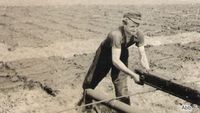From muscle power to steam to diesel
The oldest industrial peat cutting in Lower Saxony was founded in 1872 in the Great Moor near Gifhorn. The North German Peat Bog Company (Norddeutsche Torfmoorgesellschaft) Triangel was founded in 1873. In 1876 Triangel hosted an exhibition of peat machines where peat cutting methods were tested.
Machines powered by steam and diesel made work easier. Conveyor belts, peat presses and storage belts were employed.
The peat still had to be cut by hand, but the conveyor belt made transport easier. Moreover, the peat could be mechanically pressed and laid out. The heavy steam engine (Fig. 4) ran on two tracks, allowing work with the machine to be continued by relaying the tracks.
Figure 5 shows the complete team. There were also conveyor belts that had bridges fitted for holding individual sods of peat (Fig. 6).
Since about 1980, caterpillar vehicles (Fig. 7) and excavators have been used for cutting peat. The peat is harrowed and pushed together in heaps (Fig. 8) for drying.
Links to other stations in the museum:
<1> <2> <3> <4> <5> <6> <7> <8> <9> <10> <11> <12> <13> <14> <15> <16> <17> <18> <19> <20> <21> <22> <23>






